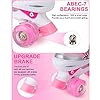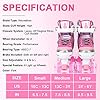Sowume Adjustable Roller Skates for Girls and Women, All 8 Wheels of Girl's Skates Shine, Safe and Fun Illuminating for Kids
41% OffSkateboarding has come a long way since the rebellious counterculture of the 1960s. Once seen as a nuisance causing damage to public spaces, skateboarding has gained widespread popularity and respect as both a recreational activity and a competitive sport.
But beyond the youth appeal and alternative style associated with skate culture, an interesting question arises – is riding ramps and ollieing over obstacles good exercise? Can it provide fitness benefits on par with traditional sports?
Let’s kickflip into the physical demands of skateboarding to see if it qualifies as a legitimate workout.
An Overview of Skateboarding’s Physicality
Skateboarding may look laidback, but shredding the streets or blasting out of bowls requires some serious athletic talents:
- Balance and coordination to control the board across uneven and unpredictable terrain
- Cardiovascular endurance to keep pushing and maintain intensity
- Muscular power in the legs, core, and back to pop ollies and stick landings
- Stamina and mental focus to handle repeated falls and keep motivation high
Unlike team sports with regular breaks and substitutions, skateboarders are on the clock from start to finish during a session. Gravity ensures there’s no coasting either. It’s a constant workout battling friction and generating enough force to maintain momentum and nail tricks.
Let’s analyze the physical toll in more detail across various skateboarding disciplines…
Street Skateboarding
Hunting for new obstacles and ledges across urban streets offers a diverse, dynamic workout:
- Each unique feature becomes a puzzle to solve creatively through trick combinations. No two sessions feel the same.
- Pushing between spots builds endurance while carrying gear tones the upper body.
- Popping ollies and jumps requires explosive lower body power.
- Landing bolts stresses balance, ankle stability and proprioception.
- Wiping out is inevitable! This tests resilience, pain tolerance and mental composure.
Overall, street skating provides highly functional cross-training with plenty of variety and skill application.
Street skating builds coordination and explosion across ever-changing environments
Vert Skateboarding
Carving the walls of massive skatebowls and halfpipes creates a high-intensity, adrenaline-filled workout:
- The elliptical pumping motion taxes the cardiovascular system maximally. Heart rates soar past 180 BPM routinely.
- Lactic acid builds fast, testing anaerobic endurance and mental grit to keep going.
- Spinning high above the coping challenges almost every muscle in demanding ways foreign to most sports.
- Repeated vertical impacts pound bones and connective tissue, forcing structural adaptations.
- Wipeouts from 10+ feet up bring devastating crashes! This requires extreme mental and physical resilience.
In terms of extreme sports, vert skating is among the most physically demanding.
Vert skating requires hardcore fitness and fearlessness to stick mega airs
Park/Bowl Skateboarding
Concrete skate parks with transition features like quarter pipes focus more on flow and airs:
- Chaining runs builds outstanding stamina across aerobic and anaerobic energy systems.
- Curving lines maintain core tension as riders snake between obstacles.
- Rhythmically transitioning transfers athleticism between upper and lower body.
- Popping out of bowls demands substantial fast-twitch muscle recruitment.
- Repeated jumps and impacts create bone density rare among non-contact sports.
As an all-around workout, shredding diverse park terrain could rival triathlons for comprehensive, functional fitness.
Concrete parks allow endless lines recombining technical skills with creativity
Clearly skateboarding qualifies as vigorous exercise by any definition. But how exactly does it impact physical health versus other traditional options? Let’s explore further…
Key Fitness Metrics Compared to Traditional Sports
While research remains limited, initial studies using power meters, oxygen tracking and biometrics reveal impressive athletic attributes among skateboarders:
Caloric Burn Rates
| Activity | Avg Calories/Hr |
|---|---|
| Skateboarding (street or vert) | ~700+ |
| Running (jogging) | 700-900 |
| HIIT workout classes | 800-1000 |
| Swimming laps | 700-800 |
Skateboarding matches solid aerobic activities for high caloric burn potential. The output depends largely on session duration and trick quantity/difficulty.
Max Heart Rate Reached
| Sport | % Max HR |
|---|---|
| Skateboarding (competitive) | Avg: 85-98% Peak: 100% |
| Soccer matches | Avg: 80-90% |
| Basketball games | Avg: 80-97% |
| Marathon running | Avg: 75-85% |
Skateboarders experience near maximum exertion levels similar to all-out competitive team sports. Maintaining this output avoids cardiovascular plateauing.
Muscular Endurance Impact
| Muscle Group | Main Skateboarding Elements |
|---|---|
| Legs | Pushing, landing bolts, absorbing impacts |
| Core | Spinning, grinding rails, managing momentum |
| Shoulders & Arms | Carving transitions, bracing maneuvers |
| Glutes & Hamstrings | Popping ollies; stabilizing landings |
Skateboarding dynamically engages both upper and lower muscle groups with constant tension and motion. Grip strength and wrist stability also see major upgrades.
On almost every performance metric from peak heart rate to muscular endurance, skateboarding equals if not exceeds traditional sports training. The full-body athletic development explains why so many pro athletes now embrace skateboarding in the offseason.
Let’s now shift gears to analyze the holistic, lifelong health impacts possible from shredding pavement…
Broader Wellness Benefits of Skateboarding
Beyond physical fitness metrics, skateboarding also boosts overall wellbeing in a few unique ways:
Creative Expression & Flow State
Unlike repetitive running or lifting routines, skateboarding leverages creativity by linking tricks fluidly through obstacles. This facilitates a highly rewarding flow state.
- The non-linear style keeps mental engagement high while allowing self-expression.
- Nailing lines triggers the satisfying flow of linking skill combos.
- Creative reward pathways reduce perceived exertion levels during sessions.
- Developing original trick sequences is both fulfilling and great for brain health.
By nurturing creative flow alongside physical intensity, skateboarding trains the body and mind in tandem.
The endless creativity of skateboarding keeps the mind immersed along with the body
Injury Resilience & Joint Mobility
Falling is inevitable in skateboarding. This teaches the body remarkable shock absorption and protects joint health long-term:
- Repeated falls train collagenous tissues to withstand trauma and remodel stronger over time.
- Quick return to feet avoids dangerous collisions while honing reactive motor patterns.
- Learning proper fall techniques reduces excessive impact forces.
- Maintaining mobility after crashes keeps the structural system resilient to loading damage.
By conditioning the body to fall safely, skateboarders develop lifelong durability against traumatic injuries.
With great crashes comes great resilience: skating into older age relies on developing shock absorption skills
Community & Mentorship Culture
Skate crews and teams form tight-knit communities eager to welcome new members regardless of skill or background. Shared learning pathways underpin the culture:
- Iconic pros often start local brands supporting rising amateur talent.
- Peer mentorship at skateparks offers positive role models for disadvantaged youth.
- Multi-generational crews provide for clashes in perspective and experience. Age matters less than shared passions.
- Events throw divergent lifestyle groups together who may not otherwise interact.
Skateboarding remains foundationally grassroots. But major competitive circuits continue emerging across street and vert formats to showcase rising talent.
Overall the welcoming vibe helps members pursue fulfillment, friendships and a sense of belonging bound by wood and urethane.
Structuring an Effective Skateboarding Workout
Hopefully you’re now convinced shredding concrete counts as earning your exercise for the day!
But rather than just casually riding, structuring sessions more strategically can maximize athletic returns. Here are some tips:
Related Product on Amazon: Sowume Adjustable Roller Skates for Girls and Women, All 8 Wheels of Girl’s Skates Shine, Safe and Fun Illuminating for Kids
Establish Objective Goals
Set measurable targets before starting like meters pushed, number of tricks landed, heart rate zones maintained, obstacles to clear or duration milestones. Quantify progress.
Track Data Over Time
Wearable tech like heart rate monitors, shot trackers (yes, those exist!) and health platforms (Apple Watch) bring valuable analytics into skating metrics. Monitor fitness markers across longer periods.
Modulate Session Intensity
Vary the duration and difficulty of rides. Include regular rest periods. Push long-range cardiovascular endurance via mellower green belt sessions and rotate in intensive interval days hammering redline vert ramps.
Structure & Repeat Routines
Create go-to routines that combine favorite terrain with drill progressions and benchmark obstacles to stimulate adaptation. Consistently repeat these weekly while adding new elements periodically to force progression.
Recover Optimally
Rehydrate, stretch and cool muscles down post-session. Time rest days to allow tissue remodeling following harder efforts. Consider compression, massage, and protein intake to speed recovery.
Treat skateboarding training with the same disciplined, progressive approach as any other athletic endeavor. Quantify sessions, periodize plans and enable quality adaptation between stimulus and recovery. This unlocks optimal athletic gains over the long run.
The Takeaway: Skateboarding as Functional Training
Skateboarding clearly checks the boxes across almost any definition of effective vigorous exercise with a unique flair. As a lifelong endeavor the skills pathway seems endless, offering fulfillment and youthfulness carrying into older age. It just takes avoiding catastrophic injury long enough!
In many ways skateboarding represents the ultimate functional training: full-body dynamic athleticism with high coordination, balance and motor control challenges. All embedded within an expressive action-sport format steeped in creativity.
Yet lingering perceptions still dismiss skateboarding as merely a recreational distraction for wayward teens rather than the legitimate fitness activity the data shows. But hopefully perspectives continue evolving to appreciate the rich athletic complexity layered below the rebellious surface.
Because beyond treating concrete like a jungle gym, skateboarding builds exceptionally well-rounded lifelong fitness with an inspiring creative soul that few other traditional sports can match.
Now grab your board and start shredding – your workout awaits!

I’m the founder of HoverboardsGuide.com, a comprehensive website dedicated to electric scooters and hoverboards. With a deep-rooted passion for electric gadgets, I’ve accumulated extensive experience in this field. I aim to assist users in selecting the best gadgets and providing reliable guidance.
I’ve tested and reviewed numerous models, gaining in-depth knowledge about their features, performance, and overall quality. Feel free to reach out to me with any queries, as I’m dedicated to addressing your concerns promptly. Join me on this exciting journey of exploring the world of electric rides and making informed decisions













